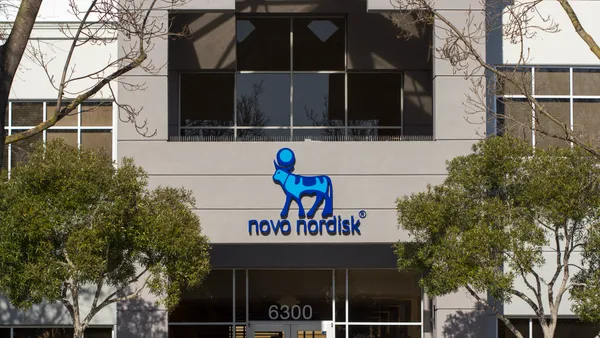Contributed by Peter H. Nalen
Beyond Hits and Clicks: A Proven Online Measurement
Approach for Online Marketing Success Like any well-crafted promotional campaign, online marketing programs must have clearly defined indicators of success. To be sure, almost every online activity can be determined and reported. The difficult and most important task is figuring out what information is worthwhile and how to get at it. Online measurement is no longer just about counting “hits and clicks.” No one would argue the importance of solid directional measurement and analytics, yet nearly one-third of pharma brands included in a recent benchmarking study reported having no success metrics for their online advertising campaigns. (See chart to the right.) So, how can your online marketing programs best be measured? How can you demonstrate the return on investment (ROI) from your online marketing programs? To achieve these goals, take a three-step approach: 1. Begin with the end in mind. 2. Use the best analytical tools available. 3. Report results as actionable marketing next steps. Great Expectations: Begin at the End To borrow a quote from best-selling author and popular motivational speaker Stephen Covey, “begin with the end in mind” when embarking on the development of online programs. Pharmaceutical marketers need to ask themselves the question: “what does/will success look like?” If measurement criteria are not identified and agreed to beforehand and expectations are not fully understood by all parties, there’s bound to be disappointment. Carve this in stone: all online efforts must be measured based on milestones established before programs are developed and launched. The time to discuss the measurement of an online marketing program is after the program has been agreed to, but before any actual development of the program has begun. By this time in the process, everyone knows the goals of the brand and the specific tactics of the online marketing program. Now is the time to identify each target audience segment and what actions or responses we want the audience to take. For example, if brand awareness or a trial is an objective, measuring the following three areas would be appropriate: 1. Reach: target audience takes a desired action or is exposed to messaging. 2. Qualification: exposed audience enters site. 3. Conversion: site visitors are exposed to critical messaging. This messaging often takes the form of key pages on a site (conversion pages); if a target interacts with the page, there is a high level of confidence that another action will take place. Then other conversion pages for each program and objective can be identified and developed. This entire process then can be measured, providing the analytics required to prove conversion. The next step is to decide what specific online metrics are available to support those three areas. For example, if an insight is that patients need to self-identify as potential users in a highly competitive category, a “qualification” action would be for them to answer an interactive quiz on the site. When patients complete the quiz, they have identified themselves as one of the brand’s segments and therefore they can be directed to site content most relevant to them. If trial is the goal and there is a downloadable or printable coupon, that page on the site is designated as a “conversion” page. At this point the number of targets sent to that page can be measured and which online media programs — search, banners, and e-mail — sent the most targets to that page can be identified and optimized appropriately. Measure for Measure: Accept Only the Best Analytics Given the vast amount of information that can be gathered about online activities, it is important to use the best analytical tools and software available, those specifically designed for online marketing program measurement. In selecting online marketing partners, make sure they are experienced with sophisticated online analytics software, such as those provided by Omniture, and understand what the software can and cannot do. Next, make sure the analytic tools of the software are built into all elements of online marketing program from Websites to each traffic-generating online vehicle used, such as banners, e-mails, paid search ads, and so on. Presenting the Findings: Make it Meaningful Finally, information — the metrics, charts, and graphs — must be reported in a compelling way that is useful to brand marketers. Pure metrics are pure torture. The information presented must be meaningful, indicating a rationale for next steps for the online program. A good best practice is to apply a simple “so what?” test to every graph and chart before sharing it with clients; only show actionable information, such as what actions should be taken — increase the program, decrease it, keep it the same, or eliminate it. Only actionable information provides the insights to enhance successful programs and eliminate those that are not meeting objectives. Online marketing programs are dynamic. The most effective ones are continually monitored using state-of-the-art analytics and techniques and altered as needed. To be truly successful, all online marketing programs, like any other marketing medium, must be integrated with the brand’s other promotion programs, developed based on the brand’s overall marketing objectives, and be consistent with the brand’s marketing strategies. Peter H. Nalen is President and CEO of Compass Healthcare Communications, Princeton, N.J., which is an independent, full-service online marketing agency exclusively supporting brands in the healthcare industry. For more information, visit compasshc.com. PharmaVOICE welcomes comments about this article. E-mail us at [email protected]. Measuring Success of Online Advertising: Benchmark Results Q: Do you have clear, well-defined and measured, success metrics associated with your online advertising campaigns? A: 32% of pharmaceutical brand managers reported no success metrics for their online advertising campaigns. Of those who have metrics of success, most are tied to product sales in some way: 63% across all the benchmark brands. Source: TGaS Advisors, East Norriton, Pa., Internet Marketing Operations Practices (iMOPs) Benchmark, June 2007. For more information, visit tgasadvisors.com.









